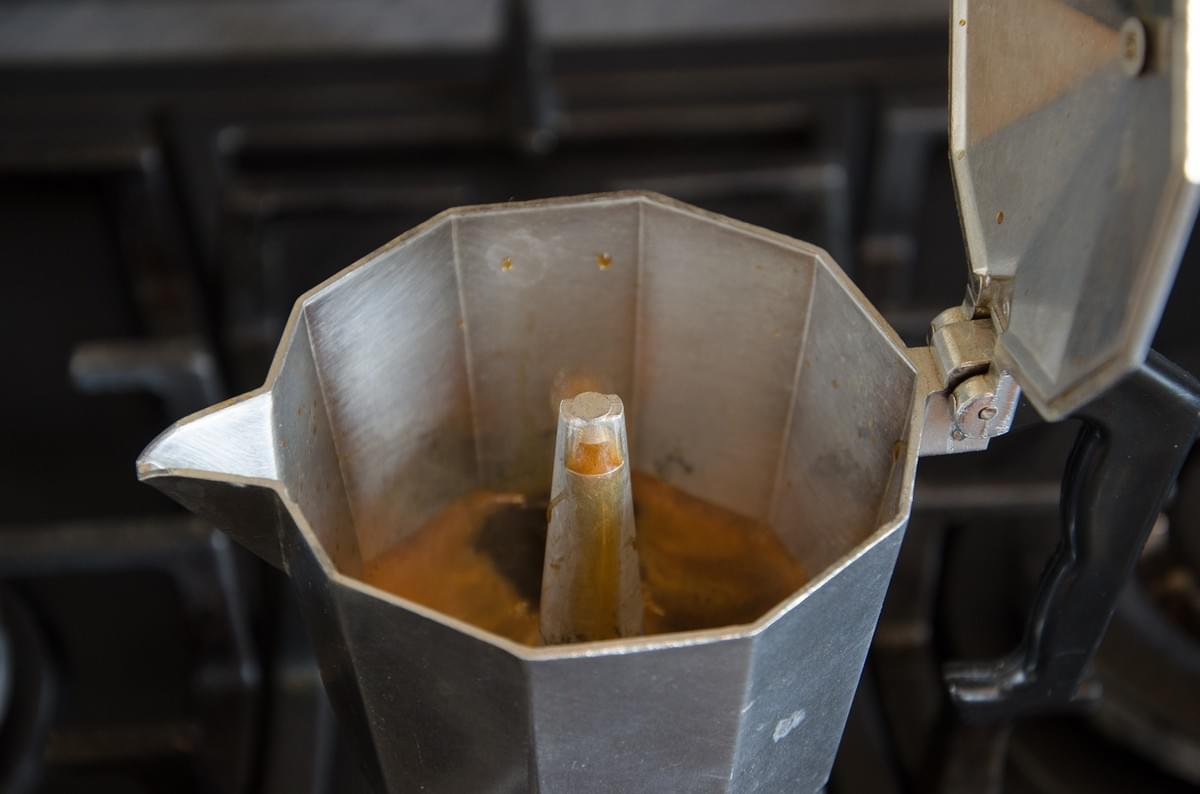Italian coffee pot using diagram _ how to cook Italian coffee pot _ is aluminum mocha pot poisonous

Professional coffee knowledge exchange more coffee bean information please follow the coffee workshop (Wechat official account cafe_style)
Somesay,Life begins after coffee, a wonderful cup of coffee can make the whole day better, but Espresso can't get around it. Unfortunately, the high cost and huge size of the coffee maker make it much higher. As a result, Philharmonic pressure has quietly become popular in the past two years, but Italians who love coffee in their bones have had espresso, the seed and source of espresso, the mocha pot, long before the Italian coffee machine was invented in the last century. Biloti is the ancestor of the Italian mocha pot. Although it has only 2-3 atmospheric pressure to extract coffee, it can still produce a perfect simple espresso, which can be used to make coffee such as latte and cappuccino with a manual milk bubble machine. The coffee made by double valves has a rich aroma. The whole extraction process is full of fun and worth having.
Wikipedia: steam brewing coffee pots, also known as mocha pots, are a way to use the pressure generated by boiling water to help make coffee. It originated in Italy and was invented by Alfanso Bialetti to see a structure that can be used to make coffee on washing machines used by local women. At that time, there was a metal tube in the middle of the washing machine, which sucked up the heated soapy water from the bottom of the washing machine and sprayed it onto the top of the clothes. AlfansoBialetti was inspired to create the world's first home coffee pot that extracts coffee under steam pressure, allowing people to brew coffee like a coffee shop at home.
Of course, Europeans do not call this kind of pot mocha pot, but call it Espresso Pot. The mocha pot refers specifically to the Biloti mocha pot. Its easy-to-carry nature is especially suitable for enthusiasts who do not have much space, and can even take it with them when they travel. I once saw a foreign commentator take one with him when participating in the 2013 Central Ring Competition. Well, I brought the mocha pot home because I couldn't do without coffee when I came home for the Chinese New year.
The coffee pot is divided into two parts, which are connected by a catheter in the middle. The following An is used to hold water. When the bottom of the coffee pot is heated to boiling, the water is converted into steam and the pressure on the water surface increases. So the boiled water goes from the catheter to part B where the ground coffee is held. After being filtered by the filter, enter part C, and then you can drink it. The coffee powder used in the mocha pot is generally ground finely, and the coffee brewed out is stronger than the ordinary dripping coffee.
In addition to other ordinary mocha pots, Biloti's mocha pot also has a unique double-valve mocha pot, that is, Brikka double-valve mocha coffee pot, which is similar to a pressure cooker. The Brikka with one more valve has a higher pressure than an ordinary mocha pot, resulting in a stronger cream and higher playability.
The octagonal shape and the villain with high fingers are the hallmarks of Biloti. Made of all-aluminum alloy, the workmanship is not as exquisite as the high-precision CNC processing now, but the rough handmade style also has a different flavor.
According to the old drivers, the long-used Biloti will have a strong coffee flavor, and the better it will be. The small bulge at the bottom of the kettle is the safety valve that all mocha pots have. When the pressure is too high, steam is discharged to prevent explosion.
And the valve engraved with the villain at the top of the pot is the magic weapon of the pot, the second pressure valve, which brings more pressure.
Let's take a look at the structure of the mocha pot: the mocha pot is divided into three parts: the upper seat, the powder trough, and the lower seat. The lower seat is a sink for holding water, and the powder trough is used to hold finely ground coffee powder. The upper layer is to hold the extracted coffee liquid.
And we need all these tools to make a strong cup of coffee from a mocha pot, and since there is no Italian steam, the task of beating milk is left to a manual bubble tank, of course, if you want to drink a cup of pure coffee, you don't need it.
Grind the coffee beans with a bean grinder and use about 18g beans for a pot of coffee. The mocha pot requires a finer degree of grinding, which is higher than that of filter drops, siphon and the Belgian royal family, and is the highest in handmade coffee. But can not reach the fineness of the espresso machine, so that part of the powder will pass through the holes into the coffee, resulting in a bad taste. At the same time, the beans in the mocha pot, like the spaghetti machine, need to be deeply roasted, resulting in stronger coffee and more Cream.
Remember not to press the coffee powder, just fill the powder trough, use a spoon to inject powder in batches, and hit the edge of the powder trough by hand so that it can be covered as much as possible without leaving gaps.
Hot water should be added to the lower seat of the kettle in advance, not more than the injection of hot water in the lower seat of the mocha pot, and the water level shall not exceed the lower edge of the safety valve. Or add water to the top seat of the measuring cup designed by Bilody to add water, and there is a H2O scale on the top seat of the pot (see previous picture). Add the right amount of water according to the scale and put it into the coffee trough. It can also be directly heated by cold water, but it is easy to be overextracted.
After adding the coffee powder, tighten the seat and heat it on the stove. When the coffee comes out of the upper valve, turn the fire down and you can see that the cream is slowly extracted.
We can see the rich cream, but because the pressure is only 2-3 Pa, the cream has not been satisfactory for a long time.
Every time you see cream slowly spill over while making coffee, you can feel the beauty of life.
After brewing a pot of successful coffee, pressed powder should be so compact and well extracted.
Pour the coffee into a hot cup and prepare the foam.
Heat the milk with a bubble tank to about 60 degrees, then pull the pull rod of the bubble tank. After about 30 times, you can get dense milk bubbles, as shown in the picture. Of course, it is a little more slippery than the milk foam from the steam, and it is not easy to operate when pulling flowers.
Finally, a wonderful latte was born.
Although the coffee made by the mocha pot is far lower in concentration and consistency than the authentic Espresso, it can barely pull the flowers.
Finally, there is a piece of sad news. Mr. Renato Biloti, the former boss of the world-famous Italian mocha coffee maker, died at the age of 93 in Ascona, Canton Ticino, Switzerland. He is the prototype of the "man with moustache" on the mocha coffee pot. At the same time, Biletti's Italian official website also released a full-page commemorative page of "go well, Renato".
He is an icon of Italian manufacturing and created a real corporate empire in the postwar years. He relies on the excellent quality of his products and a new marketing method for the entrepreneur's unique image: his cartoon character is Italy's most famous moustache, and his products continue to enter families of all sizes.
The cartoon character of the moustache man on the mocha coffee pot is famous along with the mocha coffee pot. The cartoon character was created by cartoonist Paul Campani, who had the inspiration as soon as he saw Mr. Renato Bialetti.
Also famous is the advertising slogan of the product: uh-huh. It's always so convenient! Make a good cup of coffee .
By the late 1980s, Mr. Renato Bialetti sold his business first to the Italian coffee maker Faema, and then to the Ranzoni family in Brescia, Italy, which still owns this and other Italian-made brands.
May Mr. Bilody be well in heaven and thank him for the wonderful coffee he has brought us.
END
Important Notice :
前街咖啡 FrontStreet Coffee has moved to new addredd:
FrontStreet Coffee Address: 315,Donghua East Road,GuangZhou
Tel:020 38364473
- Prev

Introduction to the principle of chemex coffee maker _ elegant hand flushing Starbucks details the difference between chemex and hand flushing
Professional coffee knowledge exchange more coffee bean information please follow the coffee workshop (Wechat official account cafe_style) in the hand coffee utensils, our most common is V60, kaital cake cup such as filter cup + filter paper combination. However, there is an instrument used by hand, which is very special. It was born in 1941 by Peter Schlum, PhD in Chemistry, University of Berlin, Germany, who moved to New York.
- Next

Bialetti Coffee maker how to use _ bialetti Coffee maker tutorial _ Coffee maker causes Cancer
Professional coffee knowledge exchange more coffee bean information please follow the coffee workshop (Wechat official account cafe_style) the mocha pot was invented by the Italian Alfonso Bialetti in 1933. The traditional mocha pot is generally made of aluminum alloy. It is easy to scratch and can only be heated by open fire, but it cannot be heated to brew coffee with an induction cooker. So now most of the mocha pots are made of stainless steel.
Related
- Beginners will see the "Coffee pull flower" guide!
- What is the difference between ice blog purified milk and ordinary milk coffee?
- Why is the Philippines the largest producer of crops in Liberia?
- For coffee extraction, should the fine powder be retained?
- How does extracted espresso fill pressed powder? How much strength does it take to press the powder?
- How to make jasmine cold extract coffee? Is the jasmine + latte good?
- Will this little toy really make the coffee taste better? How does Lily Drip affect coffee extraction?
- Will the action of slapping the filter cup also affect coffee extraction?
- What's the difference between powder-to-water ratio and powder-to-liquid ratio?
- What is the Ethiopian local species? What does it have to do with Heirloom native species?

